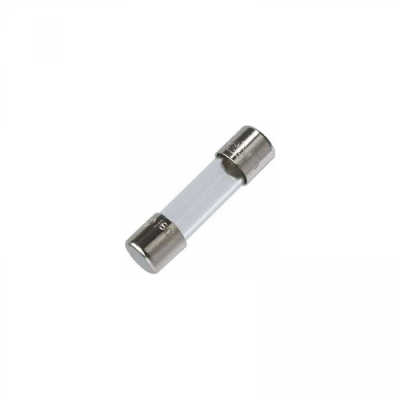Glass Fuse 6A – 250V (Size T5x20mm)
Description
Glass Fuse 6A – 250V (Size T5x20mm)
The Glass Fuse 6A – 250V (T5x20mm) is a protective component used to safeguard electrical circuits against overcurrent conditions. If the current exceeds the fuse’s rated value (6A in this case), the fuse element melts, interrupting the circuit and preventing further damage to sensitive components. This type of fuse is often used in electronic circuits, appliance protection, and power supplies.
Key Features:
- Current Rating:
- The 6A (Amp) rating indicates that the fuse is designed to handle 6 amps of continuous current. If the current exceeds this value, the fuse will blow to prevent overcurrent damage.
- Voltage Rating:
- The 250V voltage rating indicates that this fuse can safely handle voltages up to 250 volts, either AC or DC. This makes it suitable for low to medium-voltage circuits.
- Size and Dimensions:
- The T5x20mm size refers to the dimensions of the fuse. It has a 5mm diameter and is 20mm in length, which is a standard size for many household appliances, consumer electronics, and low-power equipment.
- Glass Tube Construction:
- The fuse is housed in a transparent glass tube, allowing for easy visual inspection to determine if the fuse has blown. The glass casing also offers an efficient and simple way to check the fuse’s condition without removing it from the circuit.
- Blow Type:
- This is a fast-blow fuse, meaning it is designed to blow quickly when the current exceeds the rated value. This characteristic helps protect against sudden overcurrent spikes.
- Temperature Range:
- This fuse operates over a typical temperature range of -55°C to +125°C, making it suitable for use in various environments, including industrial and consumer applications.
- Safety Certifications:
- The fuse is often UL (Underwriters Laboratories) or CE (Conformité Européenne) certified, ensuring that it meets safety standards for reliable protection in electrical systems.
Applications:
- Home Appliances:
- Commonly used in microwaves, televisions, air conditioners, blenders, and other household appliances to protect against overcurrent situations that could damage internal components.
- Consumer Electronics:
- Used to protect devices such as audio equipment, power supplies, chargers, and other electronic gadgets that operate at low to medium voltages.
- Power Supply Units:
- Employed in power supply units to safeguard against surges or short circuits that could damage the circuitry or components.
- Industrial Equipment:
- Used in industrial machinery or control panels where overcurrent protection is required to prevent equipment damage due to faults or excessive current flow.
- Automotive Circuits:
- Suitable for use in automotive systems where lower voltage protection is needed, such as for lighting circuits, radio systems, or other low-power applications.
- Lighting Circuits:
- Used in lighting systems to protect bulbs, ballasts, or LED drivers from excessive current that could cause them to fail.
Specifications:
| Specification | Value |
|---|---|
| Current Rating | 6A |
| Voltage Rating | 250V |
| Size | T5x20mm |
| Fuse Type | Glass (Clear for visual inspection) |
| Blow Type | Fast Blow |
| Temperature Range | -55°C to +125°C |
| Body Material | Glass |
| Typical Application | Household appliances, electronics, power supplies, industrial equipment |
| Certification | UL, CE (typically) |
How the Glass Fuse Works:
A glass fuse works by allowing current to pass through the metal filament inside the glass tube under normal operating conditions. However, if the current exceeds the fuse’s rated value (6A), the metal filament heats up and melts. This interrupts the circuit, preventing excessive current from damaging sensitive components downstream.
The glass casing allows for easy visual inspection to determine whether the fuse has blown. This makes it convenient for users or technicians to check and replace the fuse when necessary.
- Normal Operation: When the current is below the rated value of 6A, the fuse allows normal current flow without issues.
- Overcurrent Condition: If the current exceeds 6A, the filament inside the fuse melts, breaking the circuit and disconnecting the power.
- Visual Inspection: The transparent glass casing allows the user to see the blown fuse, indicating the need for a replacement.
Advantages of Glass Fuses:
- Cost-Effective:
- Glass fuses are affordable and provide a reliable solution for circuit protection without adding significant cost to the overall design.
- Easy Visual Inspection:
- The transparent glass casing enables easy visual checking of the fuse’s status, saving time when determining if the fuse is blown.
- Compact and Reliable:
- Glass fuses are small, lightweight, and offer reliable protection against overcurrent conditions, making them suitable for a variety of devices and applications.
- Standard Size:
- The T5x20mm size is a widely used standard, ensuring that the fuse can be easily integrated into many consumer and industrial devices.
Disadvantages of Glass Fuses:
- Fragility:
- Glass is prone to breaking upon impact, which can make glass fuses more vulnerable to physical damage compared to ceramic fuses.
- Limited Reusability:
- Glass fuses are single-use; once they blow, they need to be replaced. They do not reset like circuit breakers or polymeric fuses.
- Lower Voltage Ratings:
- The 6A – 250V glass fuse is designed for lower voltage applications, so it might not be suitable for high-voltage industrial systems or circuits with high current demands.
How to Use the Glass Fuse:
- Select the Appropriate Fuse:
- Ensure that the 6A current rating and 250V voltage rating are appropriate for your circuit. The fuse should be rated higher than the normal current but lower than the maximum tolerable current for your circuit.
- Install the Fuse:
- Insert the fuse into the fuse holder or fuse socket in your circuit. It should be placed in series with the power supply to ensure that it can interrupt the circuit when necessary.
- Inspect After Blowing:
- If the fuse blows, the glass tube will show visible signs of a broken filament, and it will need to be replaced with a new fuse of the same rating.
- Replacement:
- Never replace the fuse with a higher-rated fuse as it could allow excessive current to flow, potentially damaging the circuit. Always use the exact same fuse rating for safety and protection.
Only logged in customers who have purchased this product may leave a review.
- Image
- SKU
- Rating
- Price
- Stock
- Availability
- Add to cart
- Description
- Content
- Weight
- Dimensions
- Additional information







Reviews
There are no reviews yet.